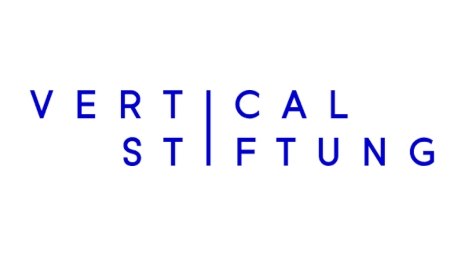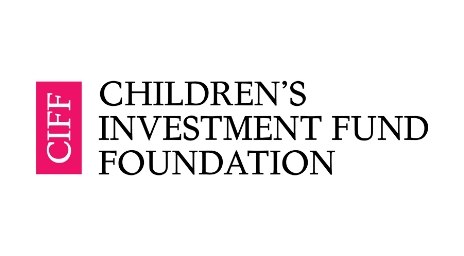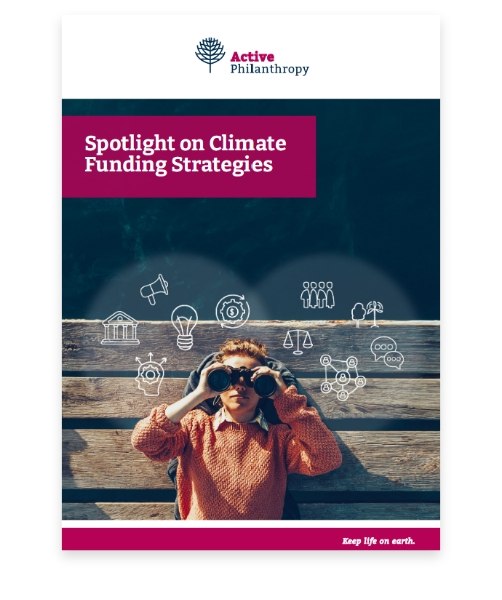Spotlight on Climate Funding Strategies
Our “Spotlight on Climate Funding Strategies” provides an overview of ten different ways to engage in climate philanthropy.
Climate funding strategies
Why effective climate funding strategies matter
Most funders agree that climate change is an urgent problem. But many are new to the topic and do not know where to start. Moreover, few foundation leaders are convinced that their strategies to address climate change are “very effective” (Orensten et al. 2022, p.22). This gap between the awareness of the climate crisis and the self-attested ineffectiveness of funding strategies calls for new approaches. Funders need to try out strategies new to them or to the region and specific climate issue that they are working on.
This website offers a practical entry point by outlining ten climate funding strategies, structured into three spheres of action: influencing, empowering, and innovating. These spheres highlight distinct ways funders can contribute—whether by shaping policies and narratives, building the capacity of communities and organisations, or supporting groundbreaking ideas and solutions.
At the heart of this website, you will find case studies that bring these strategies to life. Drawn from the experiences of 15 European and seven US funders, these real-life examples provide valuable insights into how these funding strategies are applied in practice. They offer inspiration to rethink your current funding approach and explore new partnerships, making the journey into climate philanthropy both accessible and actionable. Continue reading if you are looking for an easy entry into climate philanthropy, or if you want to better understand other climate funders. The following content aims to inspire you to rethink your current funding strategy and to consider new partnerships.
Influencing

Political Advocacy
Background analysis, policy design, engagement of decision-makers, developing evidence for policy change
Political Advocacy
Background analysis, policy design, engagement of decision-makers, developing evidence for policy change
Using the breath of funding strategies outlined in this Spotlight, philanthropy is a powerful force in sparking social changes. At the same time, philanthropy relies on governments to ensure that the implementation of these changes is scaled-up, across society.
In this context, Political Advocacy is an important funding strategy to stimulate wide-spread and long-lasting change towards climate-resilient societies.
The potential for philanthropy to leverage the power of governments is huge: The annual expenditure of European foundations amounts to just over 1 percent of the total tax revenues of EU member states.[1]
KEY INSIGHTS
- Lobbying, which directly engages policymakers around specific policy proposals, is only one aspect of Political Advocacy. Supporting Political Advocacy can also mean to fund:
- Policy analysis that informs policymakers and shapes the political debate by surfacing new insights,
- Translation of academic research into governance proposals such as legislation or administrative rule,
- Enforcement to ensure that existing legislation is implemented effectively.
- Engagement in broader alliances leads to a more powerful voice in the political arena. Political Advocacy means to work with all stakeholders involved in fostering progress on policy, of which governments are only one. Moreover, funders who become part of a broader movement or join efforts with other funders can alleviate the risk of controversy and partisanship (Bainum Family Foundation 2020).
- Political Advocacy benefits from long-term and flexible funding that gives grantees the possibility to respond to electoral cycles and new political events by changing their strategy (Watson 2022).
[1] Based on statistics from the Donors and Foundations Network in Europe (DAFNE) from 2016, the annual charitable expenditure of the 147,000 identified foundations in Europe amounts to 60 billion euros (Gavalda et al. 2021). In the same year, the total tax revenues of the EU member states amounted to just over 5,000 billion euros (Eurostat 2021).
Case Studies




Public Engagement
Raising awareness of underreported issues, direct calls to action and behavioural change, petitions, media campaigns
Public Engagement
Raising awareness of underreported issues, direct calls to action and behavioural change, petitions, media campaigns
Funders supporting Public Engagement mobilise people by changing their values, behaviours and political decisions. In the area of climate change, this relates to sustainable consumption patterns and change in the legislative and economic context of these patterns; neither are possible without the participation and acceptance of people. Main areas of funding Public Engagement are: campaigns that aim for large-scale public communication and buy-in; public deliberation processes to establish citizen perspectives on policy priorities; and local community-based initiatives that raise awareness and design calls to action (Padmanabhan and Rose 2021).
KEY INSIGHTS
- The fight against climate change is currently dominated by political inaction. Funders can respond by fostering a public call for action. Online tools such as the Climate Action Tracker raise awareness about the gap between the globally agreed 1.5°C target and governments’ inaction. Funding Public Engagement, in this sense, can help to build a “collective public mandate for climate policy” (Padmanabhan and Rose 2021), which enables politicians to act more decisively.
- Funders can appeal to change consumption choices in areas such as nutrition, energy, or transport. To avoid polarisation, it is key to focus Public Engagement on the benefits of alternative behaviours not just for the climate but for peoples’ lives. One option is to fund billboards and media campaigns that draw attention to, for example, the health benefits of cycling and improved air quality through the use of public transport.
- There is no such thing as the public. Hence, there is no one-size-fits-all solution for effective Public Engagement. Especially those groups that do not yet support climate action need to be engaged more. Funders should therefore avoid repeating long-standing engagement methods and, instead, try out new formats of engagement to mobilise new audiences.
Case Studies



Strategic Litigation
Conducting legal analysis, identifying and pursuing law cases that have impact beyond the individual case
Strategic Litigation
Conducting legal analysis, identifying and pursuing law cases that have impact beyond the individual case
Strategic Litigation is defined by legal action seeking to bring about social change with an impact beyond the individual case. It is important in the fight against climate change because it enables civil society to hold governments and corporations accountable for their climate (in)action.
- Shaping law: initiating changes in existing climate law.
- Enforcing law: legally binding climate agreements need to be enforced to make any practical difference.
- Increasing accesses to law: Helping people understand what their rights are and training legal professionals in effectively protecting the climate.
KEY INSIGHTS
- Strategic Litigation is particularly attractive for funders who want to facilitate systemic change but avoid bottom-up funding strategies. It provides an opportunity to support a tangible local case with the potential of changing an entire sector. A seminal case against Royal Dutch Shell, for example, was not only successful in court (ruling that Royal Dutch Shell must reduce its carbon emissions by 45 percent). It also contributed to a wider change of perception of Strategic Litigation as a growing risk for businesses that do not act on climate change (Clifford Chance 2021).
- The success of Strategic Litigation is not solely defined by winning (or losing) a court case. Equally important is its role of that case in shaping narratives and creating publicity for underreported issues. This is illustrated by a case against Norway’s oil drilling practices that was lost at the national supreme court but sparked a public debate, leading both to criticism from UN representatives and societal support for the demanded ban on drilling (Teulings and Pradhan 2021).
- Over the last years, Strategic Litigation has received major attention with cases nearly doubling between 2017 and 2020 (UNEP and Sabin Center for Climate Change Law 2020). More cases are great news for Strategic Litigation, which can take time to unfold its systemic potential. Funders will have the greatest impact when taking a long-term perspective and look beyond the outcome of individual cases.
Case Studies


Empowering

Capacity Building
Education, vocational training, transferable skills, peer exchange, developing ideas
Capacity Building
Education, vocational training, transferable skills, peer exchange, developing ideas
Increasing ambitions to reduce greenhouse gas emissions and to adapt to climate change poses new challenges to the world. This results in the need for new competencies. Across society, people must “obtain, improve or retain the[ir] skills, knowledge, tools, equipment or other resources” to respond effectively to the challenges we face (Climate-ADAPT 2019).
This Capacity Building is not just a necessity. It is also an important funding strategy that promises to empower individuals, organisations and communities to fight climate change – and thus generate lasting impacts beyond the funder’s engagement.
KEY INSIGHTS
- Much Capacity Building focuses on developing the knowledge and skills of professionals in different sectors, hence, improving the “technical acumen” of individuals (Cox et al. 2021). For example, funders can help to reduce the fossil fuel use in aviation by training airport staff to improve launch scheduling. Other funders, who are interested in education, can contribute to building the capacity of teachers to teach climate science to pupils (“teaching the teacher”). One example is the development of freely available teaching materials that are easily integrated into classes.
- In the fight against climate change, improving soft skills is an equally important outcome of Capacity Building. By promoting skills like leadership, negotiation or problem solving, funders can facilitate cross-sectoral innovation and help to raise the voices of people marginalised in designing climate solutions.
- Capacity Building has great potential to accelerate other funding strategies. Ultimately, the success of other funding strategies depends on the capacities of different people to implement them. Capacity Building can, for example, pave the way for Political Advocacy. By supporting programmes that enhance the understanding of young people about policy-making processes, funders can strengthen their ability to effectively advocate in the political space for more climate action.
- Capacity Building offers an opportunity to funders to be directly involved by becoming facilitators. Organising workshops, convening communities of practice and peer-exchange are formats that funders can themselves organise and thus become active beyond handing out grants.
Case Studies



Communication
Sharing information and making it accessible, building narratives, shaping social norms and values
Communication
Sharing information and making it accessible, building narratives, shaping social norms and values
Many funders are already experts in communication. They use websites, newsletters or blogs to share information and stories about their grants. This communication is an important field of funders’ operation because it can leverage the impact of a foundation by reaching key actors, changing perceptions or shaping partnerships with grantees (Wildlife Conservation Society 2021; Council on Foundations 2008; Putnam-Walkerly 2010). It is this potential of Communication to leverage impact that makes it an important climate funding strategy, too.
KEY INSIGHTS
- Information about climate change can only unfold its power if it is packaged to appeal to people. Communication is central to widen access to information about climate change to new audiences. Funders can become active, for example, by helping to translate scientific facts or technical solutions for heterogeneous audiences. The audience will determine whether journalism, music or another medium of Communication is the right strategy. One option is to make climate change visible through the power of visual images. For example, Climate Outreach, which the Calouste Gulbenkian Foundation supports, uses photography to drive evidence-based communication about climate change.
- Communication needs to appeal to emotions to motivate climate action. An effective way to do this is through stories that resonate with respective audiences (Morris et al. 2019). By telling stories, e.g. about delicious vegetarian food or the fun of riding electric bicycles in cities, funders can help to shape social norms that lead to climate-friendly behaviour. Telling stories also means to choose the right storyteller as different people trust different messengers. Whether they enable journalists, priests or medical professionals to talk more about climate change, funders have a variety of messengers to work with for whom communication is part of their daily routines.
- Another dimension of Communication is the fight against misinformation. The rapid rise of social networks and virtual media spaces has fundamentally changed the way we absorb information. A drawback of this development is the increasing spread of misinformation, also in relation to climate change (Treen et al. 2020) – which undermines collective action. Funders can help to stop this. Two ways to act stand out. Firstly, they can put pressure on social media platforms to better filter and control misinformation. Secondly, they can proactively use the virtual space to counter misinformation by strengthening digital hubs and helping to establish communities in the virtual space that share evidence-based content on climate change.
Case Studies

Direct Support
Supporting action directly on the ground (in a given locality) e.g. humanitarian aid, expenses for local ecosystem protection, building schools
Direct Support
Supporting action directly on the ground (in a given locality) e.g. humanitarian aid, expenses for local ecosystem protection, building schools
Funders have a long history of supporting communities in need for direct help. As philanthropy has developed into a professional sector, this support has become embedded in complex theories of change that aim for shifting the systems in which communities are situated.
In the face of climate change, Direct Support remains an important funding strategy. When droughts, floods or storms hit, affected people and ecosystems require support for relief and reconstruction. This is particularly relevant for the vulnerable regions of the Global South.
Direct Support is not just reactive but also strategic in building long-term resilience. For example, when it comes to restoring ecosystems and the services they provide, e.g. by storing carbon or excessive rainfall.
KEY INSIGHTS
- Direct Support allows funders to have a visible impact in a specific location. Funders who use this strategy, therefore, find it relatively easy to plan for a specific impact and subsequently evaluate the success of such plan.
- When time is of the essence and where local needs are urgent, funders are well advised to use Direct Support as a funding strategy. Direct Support is an effective strategy particularly where other funding strategies fail to unfold their potential. For example, Political Advocacy takes time to bring about structural changes and its implementation requires basic capacities to be in place. For example, communities that lack basic services such as housing, health and schooling, find it more difficult to advocate for their rights and, indeed, to engage with NGOs receiving funding for running campaigns or pressuring decision-makers.
- Direct Support can create a basis for other funding strategies and nurture lasting changes (Goldsmith 2021). Although Direct Support is not primarily aimed at structural change, it allows for climate solutions to be piloted on a small scale. These pilots can build the evidence for best practices to be scaled up. What is more, best practices can be disseminated into the public and political sphere through Communication and Political Advocacy.
Case Studies

Grassroots Support
Empowering marginalised groups, movement building, civil disobedience, bottom-up initiatives
Grassroots Support
Empowering marginalised groups, movement building, civil disobedience, bottom-up initiatives
Climate change is a global phenomenon, but it will bear its costs locally in communities. Putting those communities at the centre is thus an effective climate funding strategy. At the heart of Grassroots Support is the idea that local, self-organised communities can be effective stewards of climate solutions. Funders who recognise the people behind grassroots movements as leaders can unleash transformative power.
Yet, Grassroots Support accounts for only 0.7-1.2 percent of funding from European climate funders (Roeyer et al. 2021). Especially bigger funders face a barrier: their funding infrastructure matches the organisational set-up of large, established grantees better than those of grassroots movements, which are often small and informally organised (Ng 2021; Baykara 2016).
KEY INSIGHTS
- Grassroots Support can require funders to go the extra mile. Grassroot movements are often driven by volunteers who are more loosely organised than the staff of professional NGOs. Funders are thus advised to use different methods of identifying and engaging with grassroots movements. Funders who share calls for funding proposals via social media, will be able to better reach small groups. Equally, small but long-term grants can meet the needs of grassroots movements while not burdening them with the administration of large grants.
- Grassroots organisations are often deeply embedded in a local context. Hence, they are close to the impacts of climate change and to climate solutions (Elliott et al. 2019). Because of this proximity to local events, there is a lot to be gained from Grassroots Support. Most importantly, grassroots organisations can reach people that larger NGOs might not: “monolingual non-English speakers, undocumented workers, tenants living in slum conditions, formerly incarcerated individuals, unhoused neighbours, and many others” (Goldsmith 2021).
- With some solutions to climate change, working with grassroots communities is indispensable. One of them is stopping deforestation, to which indigenous communities are key (Food and Agriculture Organization of the United Nations and FILAC 2021). Although indigenous lands account for almost 80 percent of the Earth’s biodiversity, indigenous people have limited sovereignty over that land (Sobrevila 2008; Trewin et al. 2021). Grassroots Support of indigenous people can help to change this. What is more, evidence abounds that Grassroots Support is not only essential but also cost-effective. For example, an analysis shows that Extinction Rebellion UK performs 12 times better at carbon avoidance than the Clean Air Task Force, one of the top-rated climate organisations in the world (Ozden 2022).
Case Studies

Networks
Exchanging knowledge and best practices, building coalitions, creating consensus, strengthening infrastructure for closer collaboration
Networks
Exchanging knowledge and best practices, building coalitions, creating consensus, strengthening infrastructure for closer collaboration
Social change necessitates collaboration between different stakeholders. Indeed, throughout history, social breakthroughs such as ending apartheid in South Africa would not have been possible without active coordination among key actors from different sectors (Ditkoff and Grindle 2017). What is more, philanthropists have played an active part in supporting this coordination.
The case for climate funders to support Networks is clear: Climate change is a global challenge that affects all sectors and people in one way or the other. Without broad, cross-sector and cross-border coalitions, effective climate action is not feasible.
Funders supporting Networks can be a key force in breaking down silos and creating new coalitions of actors. Philanthropy is one step removed from political and market events and can thus act as a credible “bridge builder” (Lorentz and Meier 2012) between those holding particular stakes in these events.
What is more, funders can avoid duplication or increase the visibility of a funding area by engaging in Networks with other funders like funder collaboratives or giving circles (see the case study of the Climate and Land Use Alliance).
KEY INSIGHTS
- Funders can bring together unlike allies who have similar goals but approach them from different sectoral perspectives. For example, the ECF-funded Knowledge Network in Climate Assemblies (KNOCA) explores challenges and best practices for climate assemblies by convening policymakers, researchers, and civil society actors. Similarly, funders can bring together alike allies who have similar approaches but have not yet engaged in mutual exchange.
- Funders are well placed to go beyond the geographical borders of political or administrative entities. A transnational exchange can identify common goals, develop transnational solutions, and strategies for scaling them up. One example is C40 Cities, a global network of mayors with the mission to halve the emissions of its member cities by 2030.
- Supporting Networks is not simply an end in itself. By initiating or strengthening networks, funders contribute to the amplification of voices (and resources) that can then be heard louder outside the network itself. As a result, funding Networks can pave the way for effective Political Advocacy or help grassroots movements to thrive.
Case Studies



Innovating

Capital
Providing risk capital, mission-related investments, engaging in shareholder activism
Capital
Providing risk capital, mission-related investments, engaging in shareholder activism
European foundations hold assets and endowments of 511 billion EUR (Philea 2021). Whereas most of this money is invested in global financial markets, a smaller share of 60 billion EUR is spent on grants that foster the foundations’ missions.
Funders predominantly invest their endowment in financial markets to generate revenue for grants and operations. In doing, so they also invest in “small pieces of global capitalism”.[1] They influence financial markets and, often, support businesses with objectives that run contrary to the objectives of their grantees.
Instead, being more strategic about the use of Capital means to use a greater share of a foundation’s assets to pursue its mission. Capital is not a way to financially support grantees, but it is a strategy to achieve a foundation’s mission through the major share of its assets.
KEY INSIGHTS
- Funders who align their investment portfolio with the envisioned impact of their grants achieve two goals at once: generate revenue and foster their mission. For climate funders this means to shift investments away from CO2 polluters to companies that develop solutions to the climate crisis. Resources such as the Climate Action 100+ database help to identify the companies with the largest greenhouse gas emissions worldwide. Funders can user their Capital in particular to bridge the “innovation gap” (Braemer 2015), investing in technologies and business models that are crucial to tackle climate change but cannot yet compete in profit-oriented financial markets. Platforms like the Prime Coalitioncan help in identifying opportunities.
- Funders can use their Capital to acquire large shares of companies. As a result, they can influence corporate decisions towards more climate-friendly practices. One way is to vote in shareholder meetings, another one is to start shareholder resolutions. These can push companies to account for their impact on climate change (Braverman 2018). Even where these strategies do not result in immediate changes to business practices, they help to hold companies to account and can build public pressure (ShareAction 2022).
- Sustainable investing without curtailing revenue is possible. Many case studies show that the inclusion of environmental, social and governance aspects (ESG) in a portfolio does not necessarily reduce returns (Müller et al. 2018). Moreover, the recent court case Butler-Sloss v Charity Commission in the UK illustrates that a responsible investment approach – defined as the inclusion of ESG factors in investment decisions – is compatible with the fiduciary duty of funders. Thus, foundations are being given the authority to weigh financial return considerations against possible conflicts with their charitable purposes (Impact Investing Institute 2022).
[1] This is how Lily Tomson from ShareAction expresses this mechanism in Active Philanthropy’s online course “Climate + Philanthropy: A Compact Learning Journey”.
Case Studies

Research & Development
Scientific research, technological development, assessment of problems and development of innovative solutions
Research & Development
Scientific research, technological development, assessment of problems and development of innovative solutions
The fight against climate change depends both on new knowledge and technological innovation. Without scientific research, we would know nothing about the reasons for climate change, not to talk about its future trajectory. Research has resulted in technologies that help to mitigate climate change such as wind- and solar power, more efficient lighting, or modern battery technologies (Nature 2022).
Big and small funders alike have a role to play in Research & Development. Smaller funders can directly support outstanding researchers e.g. through fellowships, or specific projects e.g. by piloting technological innovations. By providing long-term financial security, large funders have an exceptional capacity to shape entire research infrastructures and fields. The Bezos Earth Fund, for example, has awarded 30 million USD to the Salk Institute for research enhancing plants to capture and store more carbon to offset climate change. Often these large funding commitments build on pioneering research initially supported by smaller grants.
KEY INSIGHTS
- Funding Research & Development goes beyond traditional grants for research projects and institutes towards shaping the context in which those take place. Collaboration between different disciplines is one example. It is crucial for understanding complex topics such as climate change. Equally, opening up access to research results removes an important barrier for translating research into practice.
- Philanthropy and science are great partners when it comes to developing innovative solutions as both have the freedom to pursue untreaded paths. Funding in Research & Development cannot guarantee results such as specific insights or technological innovations. But its potential impact is significant, e.g., in case of a successful emergence of a ground-breaking technology. Compared to public or private funders of Research & Development, philanthropy is well positioned to take that risk because it is not restricted to public opinion or pursuit of financial profit.
- Scientific evidence importantly informs political and economic decisions as well as legal ones. In this sense, scientific findings, for example on the causal links between climate change and health problems, provide an increasingly important basis for argumentation in court (Schiermeier 2021). Funding for Research & Development can have important knock-on effects. Promoting these effects go beyond support for research and technological development and includes facilitating the transfer of scientific knowledge, e.g. to courts.
Case Studies



Case studies
Influencing







Empowering











Innovating





PDF download
About the Spotlight
The Spotlight explained in 2 minutes!
Loading may transfer data to YouTube. Read more in the Privacy Policy.
Our partners



Publication bibliography
Show all references
Bainum Family Foundation (2020): Creating Change Through Policy Advocacy. 10 Ways Foundations Can Engage.
Bethesda, MD (Bainum Briefs, 2). Available online at https://bainumfdn.org/wp-content/uploads/2020/09/Bainum-
Brief_Volume-2_September-2020_Print.pdf, checked on 8/5/2022
Baykara, Hilal (2016): Funding the Frontlines: The Value of Supporting Grassroots Organizing. Edited by Philanthropy
News Digest. Candid. Available online at https://philanthropynewsdigest.org/features/commentary-and-opinion/
funding-the-frontlines-the-value-of-supporting-grassroots-organizing, checked on 8/31/2022.
Braemer, Christian (2015): Philanthropy: The New Risk Capital? In Stanford Social Innovation Review. Available online
at https://ssir.org/articles/entry/philanthropy_the_new_risk_capital#, checked on 8/11/2022.
Braverman, Beth (2018): The Nathan Cummings Foundation’s Role as a Shareholder Activist. impactivate. Available
online at https://www.theimpactivate.com/the-nathan-cummings-foundations-role-as-shareholder-activist/,
checked on 8/11/2022.
Clifford Chance (2021): ESG Trends. The Rise of Climate Litigation and the Challenges for Businesses. Available online
at https://www.cliffordchance.com/content/dam/cliffordchance/briefings/2021/07/esg-trends-the-rise-of-climate-
litigation-and-the-challenges-for-business.pdf, checked on 8/16/2022.
Climate-ADAPT (2019): Capacity building on climate change adaptation. Available online at https://climate-adapt.
eea.europa.eu/en/metadata/adaptation-options/capacity-building-on-climate-change-adaptation, checked on
11/9/2022.
Council on Foundations (2008): Solutions Brief. Strategic Communications. Available online at https://cof.org/sites/
default/files/documents/files/Strategic%20Communications%20Solutions%20Brief.pdf.
Cox, Suzanne; Hellstern, Tom; Henderson, Kimberley; Nowski, Tracy; O’Flanagan, Maisie; Pinner, Dickon et al. (2021):
It’s time for philanthropy to step up the fight against climate change. McKinsey. Available online at https://www.
mckinsey.com/business-functions/sustainability/our-insights/its-time-for-philanthropy-to-step-up-the-fight-against-
climate-change, checked on 8/9/2022.
Ditkoff, Susan Wolf; Grindle, Abe (2017): Audacious Philanthropy. Edited by Harvard Business Review. Harvard
Business Review. Available online at https://hbr.org/2017/09/audacious-philanthropy, checked on 11/17/2021.
Elliott, Matthew; Berger, Michael; Bidad, Helia (2019): Soil to Sky: Climate Solutions that Work. California
Environmental Associates. Available online at https://climasolutions.org/wp-content/uploads/2019/09/Soil-to-Sky-1.
pdf, checked on 11/18/2022.
Eurostat (2021): EU tax and social contribution revenue decreased in 2020. European Commission. Available online at
https://ec.europa.eu/eurostat/de/web/products-eurostat-news/-/ddn-20211029-2.
Food and Agriculture Organization of the United Nations; FILAC (2021): Forest governance by indigenous and tribal
peoples. An opportunity for climate action in Latin America and the Caribbean. FAO. Santiago. Available online at
https://www.fao.org/3/cb2953en/cb2953en.pdf, checked on 8/16/2022.
Gavalda, Manon; Dupont, Capucine; Brodin, Claire (2021): Philanthropy and development. Stocktake and partnership
strategy. Ministère de l’Europe et des Affaires Étrangères. Available online at https://www.diplomatie.gouv.fr/IMG/
pdf/rapport_drm_philanthropy_eng_web_cle0ab7b4.pdf, checked on 8/15/2022.
Goldsmith, Shane Murphy (2021): A Lesson From COVID: Direct Relief and Systems Change Funding Are Inseparable.
Edited by Inside Philanthropy. Available online at https://www.insidephilanthropy.com/home/2021/3/17/a-lesson-
from-covid-direct-relief-and-systems-change-funding-are-inseparable, checked on 8/5/2022.
Impact Investing Institute (2022): Butler-Sloss v Charity Commission marks a decisive step forward for investing
with impact in charitable foundations’ endowments. Available online at https://www.impactinvest.org.uk/butler-
sloss-v-charity-commission-marks-a-decisive-step-forward-for-investing-with-impact-in-charitable-foundations-
endowments/, checked on 9/7/2022.
Lorentz, Bernhard; Meier, Johannes (2012): Strategische Philanthropie zum Klimaschutz. Ansätze am Beispiel
der Stiftung Mercator und der European Climate Foundation. Edited by Stiftung & Sponsoring – Das Magazin für
Nonprofit-Management und -Marketing. Berlin, Essen (Rote Seiten). Available online at https://www.stiftung-
mercator.de/content/uploads/2020/12/Strategische_Philanthropie_Klimaschutz.pdf.
Morris, Brandi S.; Chrysochou, Polymeros; Christensen, Jacob Dalgaard; Orquin, Jacob L.; Barraza, Jorge; Mitkidis,
Panagiotis (2019): Stories vs. facts: triggering emotion and action-taking on climate change. In Climatic Change 154
(1), pp. 19–36. Available online at https://link.springer.com/article/10.1007/s10584-019-02425-6, checked on 8/9/2022.
Müller, Markus; Börger, Enrico; Bovenzi, Michele (2018): CIO Insights Reflections. Positiven Einfluss ausüben – auf
Rendite und Gesellschaft. ESG bewerten. Deutsche Bank Wealth Management. Available online at https://
deutschewealth.com/content/dam/deutschewealth/cio-as-sets/esg/CIO%20Insights%20Reflections%20ESG%20
Positiven%20Einfluss%20aus%c3%bcben%20WM%20German%20client%20ready.pdf, checked on 11/14/2022.
Nature (2022): How researchers can help fight climate change in 2022 and beyond. In Nature 601 (7891), p. 7. DOI:
10.1038/d41586-021-03817-4.
Ng, Alice (2021): Why Big Philanthropy Falls Short at Supporting the Grassroots—and How it Can Do Better. Inside
Philanthropy. Available online at https://www.insidephilanthropy.com/home/2021/8/31/why-big-philanthropy-falls-
short-at-supporting-the-grassrootsand-how-it-can-do-better, checked on 8/5/2022.
Orensten, Naomi; Malmgren, Katarina; Lopez, Maria (2022): Much Alarm, Less Action. Foundations & Climate
Change. The Center for Effective Philanthropy. Cambridge, MA. Available online at http://cep.org/wp-content/
uploads/2022/07/CEP_Much_Alarm_Less_Action.pdf, checked on 8/8/2022.
Ozden, James (2022): Protest Movements Could Be More Effective Than the Best Charities. Stanford Social Innovation
Review. Available online at https://ssir.org/articles/entry/protest_movements_could_be_more_effective_than_the_
best_charities, checked on 11/18/2022.
Padmanabhan, Chandrima; Rose, Katie (2021): Public Engagement on Climate Change. A Case Study Compendium.
Centre for Public Impact; Calouste Gulbenkian Foundation (UK Branch). Available online at https://www.
centreforpublicimpact.org/assets/documents/cpi-cgf-public-engagement-climate-change-case-studies.pdf, checked
on 8/9/2022.
Philea (2021): Data on the sector. Available online at https://philea.eu/how-we-can-help/knowledge/data-on-the-
sector/, checked on 8/23/2022.
Putnam-Walkerly, Kris (2010): 15 Ways to Improve Grantee Communication at Your Foundation. Available online at
https://putnam-consulting.com/practical-tips-for-philanthropists/philanthropy/improve-grantee-communication/,
checked on 8/3/2022.
Roeyer, Hannah; Desanlis, Helene; Cracknell, Jon (2021): Foundation funding for climate change mitigation. Europe
Spotlight. Climateworks; EFC; The Hour Is Late. Available online at https://www.climateworks.org/wp-content/
uploads/2021/10/CWF_Funding_Trends_Report_Europe_2021.pdf, checked on 10/13/2021.
Schiermeier, Quirin (2021): Climate science is supporting lawsuits that could help save the world. News Feature. In
Nature. Available online at https://www.nature.com/articles/d41586-021-02424-7, checked on 8/16/2022.
ShareAction (2022): Shareholder Activism. ShareAction. Available online at https://shareaction.org/unlocking-the-
power/shareholder-resolutions, checked on 8/11/2022.
Sobrevila, Claudia (2008): The Role of Indigenous Peoples in Biodiversity Conservation. The Natural but Often
Forgotten Partners. The World Bank. Washington, D.C. Available online at https://documents1.worldbank.org/
curated/en/995271468177530126/pdf/443000WP0BOX321onservation01PUBLIC1.pdf, checked on 8/12/2022
Teulings, Jasper; Pradhan, Shishusri (2021): Assessing the impact of climate litigation. Edited by Alliance Magazine.
CIFF. Available online at https://www.alliancemagazine.org/blog/assessing-the-impact-of-climate-litigation/,
updated on 3/3/2021, checked on 8/16/2022
Treen, Kathie M. d’I.; Williams, Hywel T. P.; O’Neill, Saffron J. (2020): Online misinformation about climate change.
Available online at https://wires.onlinelibrary.wiley.com/doi/pdf/10.1002/wcc.665, checked on 8/3/2022.
Trewin, Blair; Morgan-Bulled, Damian; Cooper, Sonia (2021): Climate: National and international frameworks.
Australian Government Department of Agriculture, Water and the Environment. Canberra (Australia State of the
environment 2021). Available online at https://soe.dcceew.gov.au/climate/management/national-and-international-
frameworks.
UNEP; Sabin Center for Climate Change Law (2020): Global Climate Litigation Report. 2020 Status Review.
Nairobi, Kenya. Available online at https://wedocs.unep.org/bitstream/handle/20.500.11822/34818/GCLR.
pdf?sequence=1&isAllowed=y, checked on 8/16/2022.
Watson, Sara (2022): 16 Grantmaking Characteristics to Effectively Support Public Policy Advoca-cy. Edited by Bolder
Advocacy. Available online at https://bolderadvocacy.org/resource/16-grantmaking-characteristics-to-effectively-
support-public-policy-advocacy/, checked on 8/5/2022.
White & Case LLP (2018): Climate change litigation. A new class of action. London. Available online at https://www.
actu-environnement.com/media/pdf/news-33084-leadership.pdf, checked on 8/16/2022.
Wildlife Conservation Society (2021): Strategic Communications. Amplifying Succesful Conservation. Wildlife
Conservation Society. Available online at https://www.wcsclimateadaptationfund.org/strategic-communications,
checked on 8/11/2022.



Get in touch
Please direct your inquiries, comments, feedback or questions related to the guide to Dr. Johannes Lundershausen and/or Louis Wilß.
